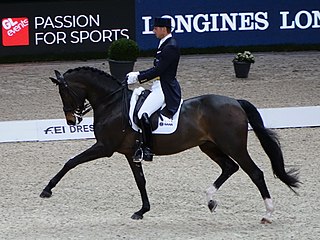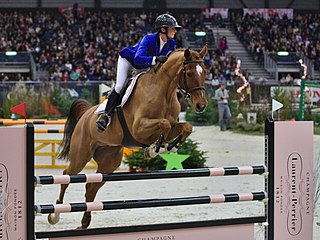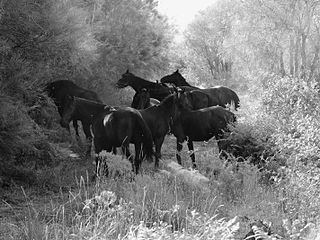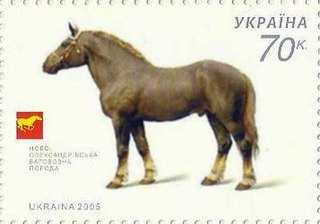
The Ukrainian Riding Horse or Ukrainian Saddle Horse is a modern Ukrainian breed of warmblood sport horse. Breeding began in the years after the Second World War at the stud farm of Dnipropetrovsk in central Ukraine – at that time in the USSR – and later expanded to three other state stud farms. It derives from cross-breeding of Hanoverian, Thoroughbred and Trakehner stallions with local mares or with Hungarian Furioso, Gidran Arab or Nonius mares. It incorporates the last bloodlines of the extinct Orlov-Rostopchin or Russian Saddle Horse. It was bred to compete in show jumping, three-day eventing and dressage, but is also suitable as a general riding horse.

The Belarus Harness Horse, Belarusian: Беларускі запражны конь, romanized: Bielaruski zapražny koń, is a Belarusian breed of draught horse. It was bred for use in agriculture, and is also used to produce mare's milk and horsemeat.

The Swedish Warmblood is a Swedish breed of warmblood horse. It was originally bred as a cavalry horse at the Strömsholm, Ottenby and Flyinge studs. In the twentieth century it became a general-purpose riding and sport horse. It performs well in dressage, show-jumping and three-day eventing, and also as a harness horse.

The Swiss Warmblood or Schweizer Warmblut is a modern Swiss breed of warmblood sport horse. It was created in the mid-twentieth century by merger of the Einsiedler – which had been bred for centuries at the Benedictine Monastery of Einsiedeln in the Canton of Schwyz – with the Swiss Halfblood and with traditional local breeds including the Ajoie, the Erlenbacher and the Entlebucher. It is sometimes known as the Neue Einsiedler. The Swiss Warmblood is bred at the Haras National Suisse at Avenches, in the Canton of Vaud.

The Soviet Heavy Draft is a Russian breed of heavy draft horse. It derives from the Belgian Brabant heavy draft breed. It was developed in the former Soviet Union for agricultural draft work, and was recognized as a breed in 1952. It is one of several heavy draft breeds developed in the Soviet Union in the twentieth century, others being the Russian Heavy Draft – which derived mainly from the Ardennais – and the Vladimir Heavy Draft, which was derived principally from the Clydesdale.

The Latvian Horse is a purpose-bred warmblood horse breed from Latvia. Breeding began in Latvia in the early twentieth century, and a herd book was established in 1927. The breed was officially recognised in 1952. There are two types, sometimes called the Latvian Harness Horse and the Latvian Riding Horse. The harness type was predominant until about 1960, when demand for sport horses increased and more of the saddle type were bred.

The Rhenish German Coldblood, German: Rheinisch Deutsches Kaltblut, is a breed of heavy draught horse from the Rhineland area of western Germany. It was bred in second part of the nineteenth century, principally at the Prussian state stud at Schloss Wickrath in Wickrathberg, now part of Mönchengladbach in North Rhine-Westphalia.

The Deliboz is an Azerbaijani breed of light riding horse. It is an ancient breed which underwent selective breeding in the Azerbaijan Soviet Socialist Republic in the twentieth century. It is one of four extant horse breeds in Azerbaijan, the others being the Karabakh, the Guba and the Shirvan. It may also be called Daliboz or Dilbaz.

The Novokirghiz or New Kirghiz is a modern Kyrgyz breed of horse. It was developed in the Kirghiz Soviet Socialist Republic in the mid-twentieth century through cross-breeding of the traditional Kyrgyz Horse of the region with introduced horses of Thoroughbred, Don and Anglo-Don stock.

The Gelderlander is a Dutch breed of warmblood horse. It was bred in the province of Gelderland in the Netherlands as a carriage horse capable also of farm work. It declined in popularity in the mid-twentieth century. In 1965 it was one of the foundation breeds of the Dutch Warmblood or KWPN, the other being the heavier Groninger horse from the north. It is registered in a division of the Royal Dutch Warmblood Horse Studbook, which also has divisions for the Dutch Warmblood and for the Dutch Harness Horse.

The Sanfratellano or Razza di San Fratello is an Italian breed of riding horse. It originates in the comune of San Fratello, in the Nebrodi Mountains in the province of Messina in north-eastern Sicily. It is one of three Sicilian breeds, the others being the Purosangue Orientale and the Siciliano Indigeno.

The Sardinian Anglo-Arab or Anglo-Arabo Sardo is an Italian breed of riding horse from the Mediterranean island of Sardinia. It derives from cross-breeding of local mares with stallions of Arab, Anglo-Arab and Thoroughbred stock. Breeding began in 1874; the breed was officially recognised in 1967.

The Rhinelander, or Rheinisches Reitpferd, is a German warmblood breed of sport horse. It is traditionally bred at the Warendorf State Stud, which it shares with the Westphalian, and is bred to the same standard as the Westphalian and other German warmbloods, such as the Bavarian Warmblood, Mecklenburger, Brandenburger, and Württemberger.
The Tersk Stud is a horse stud farm, and it was used to restore the Russian horse population, which suffered heavy losses during the 1917-1923 Revolution. It was officially established on 11 February 1921, on the orders of Marshal Semyon Budyonny.
The Vlaamperd is a South African breed of light draught or harness horse; it is also suitable for riding and is used in dressage. It was bred in the Western Cape region of South Africa in the early twentieth century, and resulted from cross-breeding of local mares with imported European stallions, particularly Friesians. The horses are usually black, though mares may be dark seal brown. A stud-book was started in 1983.
Western Sudan Pony is an exonym for a Sudanese breed or group of breeds or ecotypes of small horse or pony. These are distributed principally in southern Darfur and south-western Kordofan, extending into southern Chad, and are known generically as Gharbaui ("western") or by a variety of regional names including Darfur Pony and Kordofani.

The Senner or Senne is a critically-endangered German breed of riding horse. It is believed to be the oldest saddle-horse breed in Germany, and is documented at least as far back as 1160. It is named for the Senne, a natural region of dunes and moorland in Nordrhein-Westfalen, in western Germany, and lived in feral herds there and in the Teutoburger Forest to the east.

The Novoolexandrian Draught is a Ukrainian breed of draught horse. It is named for the state stud farm of Novo-Oleksandrivka in Bilovodsk Raion of Luhansk Oblast in the easternmost part of Ukraine, where it was bred. It shares its early history with the Russian Heavy Draught bred in Imperial Russia in the second half of the nineteenth century, and until after the Russian Revolution known as the Russian Ardennes; later development took place in Ukraine, where it received official recognition in 1999. It was bred for draught work, but it is also reared for meat and particularly for mare's milk, of which it is a high-yielding producer.

The Strelets Arab or Strelets Horse is an extinct Ukrainian breed of light cavalry horse. It was bred in the nineteenth century at the Striletsky State Stud in Luhansk Oblast of Ukraine, from Arab and a variety of other stock. As with other Russian horse populations, its numbers were gravely reduced by the events of the Russian Revolution and the Russian Civil War, and it came close to disappearing. Two stallions and a few mares survived, which was judged to be too small a number to allow the breed to be recovered. Instead, they were taken to the Tersk Stud in the North Caucasus and used as the foundation stock in the development of the new Tersk breed of riding horse. The Strelets also contributed to the development of the Don and Kustanai breeds.
The Sudanese Country-Bred is a Sudanese breed of light riding horse. It was bred in the twentieth century by cross-breeding local mares of Barb type with imported Arab or Thoroughbred stallions.

















